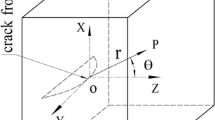Abstract
In this paper, an experimental technique to determine the stress intensity factor KIII for three-dimensional cracks using the method of reflected caustics in combination with the photoelastic stress-freezing and stress-releasing techniques is presented. The experimental model is a cylindrical bar with a three-dimensional surface crack under a load of pure torsion. To obtain the caustic pattern, a slice cut from the frozen model is annealed to release the frozen-stress. The results of this experimental method coincide favorably with the theoretical analysis results of Tweed and Rooke. Moreover, the mixed-mode stress intensity factors KII and KIII of the three-dimensional crack are separately determined using the photoelastic and caustic methods. By using the present experimental technique, the mixed-mode stress intensity factors KII and KIII for a three-dimensional crack are found to be easily separated.




















Similar content being viewed by others
References
Manogg P (1964) Schattenoptische Messung der spezifischen Bruchenergie während des Bruchvorgangs bei Plexiglas. Proocedings of the International Conference on the Physics of Non-Crystalline Solids. Delft, The Netherlands, pp 481–490
Theocaris PS, Joakimides N (1971) Some properties of generalized epicycloids applied to fracture mechanics. Z Angew Math Phys 22(5):876–890
Theocaris PS, Gdoutos E (1972) An optical method for determining of opening-mode and edge sliding-mode stress intensity factors. J Appl Mech 39(1):91–97
Theocaris PS (1981) Elastic stress intensity factors evaluated by caustics. Mech Fract 7:189–252
Beinert J, Kalthoff JF (1981) Experimental determination of dynamic stress intensity factors by shadow patterns. Mech Fract 7:281–330
Rosakis AJ, Ma CC, Freund LB (1983) Analysis of the optical shadow spot method for a tensile crack in a power-law hardening material. J Appl Mech 50(4a):777–782
Theocaris PS, Razem C (1977) Deformed boundaries determined by the method of caustics. J Stain Anal Eng Des 12(3):223–232
Theocaris PS, Papadopoulos GA (1981) Stress intensity factors from reflected caustics in birefringent plates with cracks. J Stain Anal Eng Des 16(1):29–36
Baik MC, Choi SH, Hawong JS, Kwon JD (1995) Determination of stress-intensity factors by the method of caustics in anisotropic materials. Exp Mech 35(2):137–143
Semenski D (1997) Method of caustics in fracture mechanics of mechanically anisotropic materials. Eng Fract Mech 58(1-2):1–10
Rosakis AJ, Freund LB (1982) Optical measurement of the plastic strain concentration at a crack tip in a ductile steel plate. J Eng Mater Technol 104(2):115–120
Meyn DA (1989) Hydrogen-assisted cracking studies of 4340 steel by using the optical method of caustics. Eng Fract Mech 33(6):913–925
Theocaris PS (1971) Reflected shadow method for the study of constrained zones in cracked plates. Appl Opt 10(10):2240–2247
Rossmanith HP (1979) Determination of stress intensity factors by the dynamic method of caustics for optically isotropic materials. Ing Arch 48(6):363–381
Badalouka BG, Papadopoulos GA (2012) Experimental evaluation of the plastic zone at crack tip by caustics. Open Mech Eng J 6:83–89
Can T (2014) Experimental investigation of the fiber bundle shielding effect on the dynamic matrix crack using optical caustic method. Polym Test 40:46–53
Yang RS (2009) Dynamic fracture behavior of rock under impact load using the caustics method. Min Sci Technol 19(1):79–83
Theocaris PS (1981) The reflected caustics method for the evaluation of mode III stress intensity factor. Int J Mech Sci 23(2):105–117
Taudou C, Ravi-Chandar K (1992) Experimental determination of the dynamic stress intensity factor using caustics and photoelasticity. Exp Mech 32(3):203–210
Yazdanmehr A, Soltani N (2014) Evaluation of stress intensity factors of rounded V and U notches under mixed mode loading, using the experimental method of caustics. Theor Appl Fract Mech 74:79–85
Raftopoulos DD, Farahmand B (1982) An investigation of stress intensity factors for plates with equal and unequal parallel edge cracks. Int J Fract 20(3):223–239
Rosakis AJ, Ravi-Chandar K (1986) On crack-tip stress state: an experimental evaluation of three-dimensional effects. Int J Solids Struct 22(2):121–134
Yao Jianchu, Chu Kunliang (1988) A study of three-dimensional cracked-body problems by caustics. Proceedings of the international conference on advanced experimental mechanics, pp 153–158
Lai ZM, Sun P (1983) Photoelastic determination of mixed mode stress intensity factor KI KII and KIII. Exp Mech 23(2):228–235
Theocaris PS, Georgiadis HG (1984) Mode III stress-intensity factors in cracked orthotropic plates—an analogy with propagating cracks in isotropic media. Exp Mech 24(3):177–183
Kalthoff JF (1987) The shadow optical method of caustics. In: Static and dynamic photoelasticity and caustics, pp 407–522
Tweed J, Rooke DP (1972) The torsion of a circular cylinder containing a symmetric array of edge cracks. Int J Eng Sci 10(9):801–812
Rooke DP, Cartwright DJ (1976) Compendium of stress intensity factors. Her Majesty’s Stationery Office, London
Sih GC (1981) Mechanics of fracture. Martinus Nijhoff Publishers, The Hague/ Boston/ London
Katsuhiko W, Toshiaki H, Yasuo H, Hideo K (1978) Photoelastic analyses of three-dimensional crack problems by newly-developed method presenting accurate solution. Trans Jpn Soc Mech Eng 44(388):4040–4051
Sih GC (1973) Methods of analysis and solutions of crack problem. Noordhoff International Publishing, Leyden
Ramesh K, Gupta S, Akelkar A (1997) Evaluation of stress field parameters in fracture mechanics by photoelasticity-revisited. Eng Fract Mech 56(1):25–45
Acknowledgments
The authors thank the National Natural Science Foundation of China (No. 11427802 and No. 11172026) and the Specialized Research Fund for the Doctoral Program of Higher Education (No. 20131102110014) for their supports.
Author information
Authors and Affiliations
Corresponding author
Rights and permissions
About this article
Cite this article
Wu, D.F., Shang, L., Pu, Y. et al. Determination of Stress Intensity Factor KIII for Three-Dimensional Crack by Using Caustic Method in Combination with Stress-Freezing and Stress-Releasing Technique. Exp Mech 56, 463–474 (2016). https://doi.org/10.1007/s11340-015-0113-2
Received:
Accepted:
Published:
Issue Date:
DOI: https://doi.org/10.1007/s11340-015-0113-2




